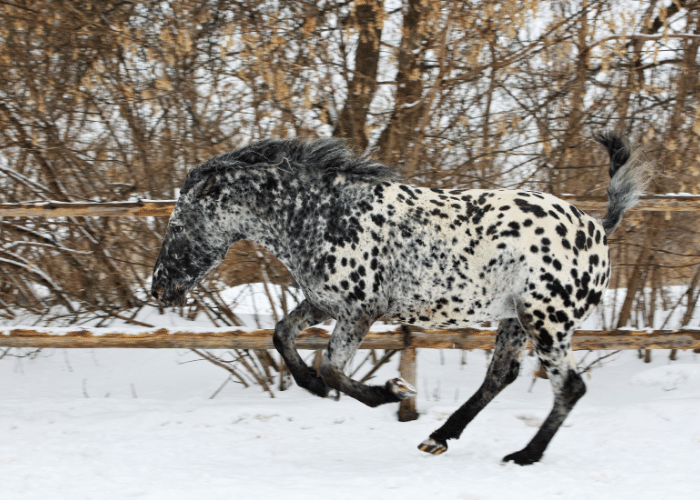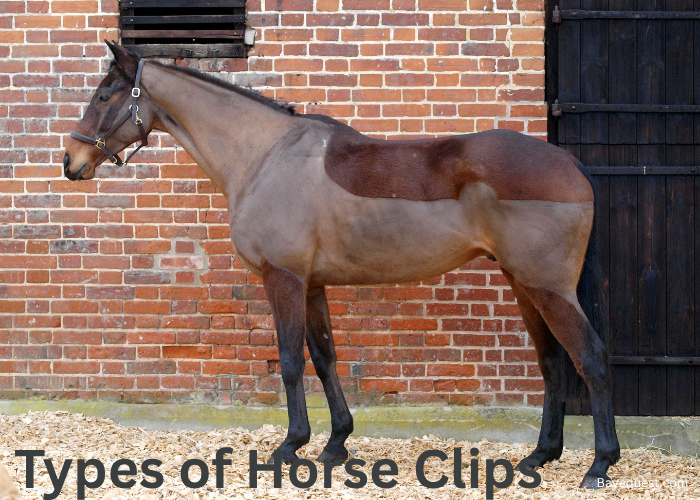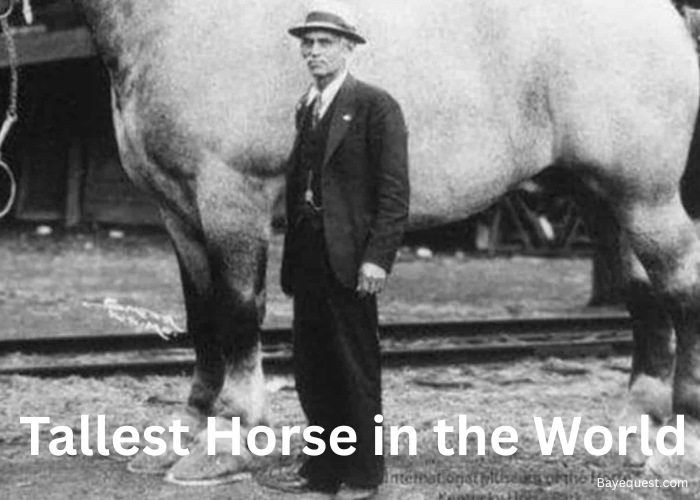A horse as unique as a fingerprint, with a coat dotted like the night sky, embodies the allure of spotted horse breeds. These patterns, steeped in history, have always fascinated us.
From the war mounts of legends to today’s show ring champions, these breeds showcase a mosaic of colors that transcend the ordinary.
This blog, ‘spotted horse breeds’ uncovers the magic behind their markings.
Prepare to be captivated by the world’s most extraordinary equines.
Which is the Most Common Speckled Horse?
The most common speckled horse is the Appaloosa, an American breed renowned for its colorful spotted coat. This breed exhibits a diverse range of body types due to its mixed heritage. The Appaloosa’s distinct spots and versatility make it the most recognized speckled horse globally.
Spotted Horse Breed History
The story of spotted horses is as old as time itself. Picture this: ancient cave walls, the first canvases, adorned with images of horses dappled in spots.
These horses weren’t just figments of imagination; they were revered creatures, companions in war and peace. As civilizations rose and fell, these spotted beauties remained a constant, a testament to their enduring allure.
Fast forward to more recent history. The Appaloosa, with its leopard spots, became the pride of the Nez Perce tribe in America.
Their careful breeding practices enhanced these horses’ stamina, intelligence, and distinctive coats. Across the ocean, Europe’s Knabstrupper shares a similar story of admiration for its polka dots.
These breeds, among others, carry the legacy of their ancestors, in their appearance and spirit. Today, they’re not just a nod to history. They’re a living piece of art, a connection to a past where a horse’s spots were as much a symbol of its strength as they were of its beauty.
In every spot and pattern, there’s a story waiting to be told, a history carried through the ages. So, as we delve into the tales of these spotted breeds, remember, we’re not just talking about horses; we’re talking about history in motion.
Interesting read: Spotted Horse Names.
What Causes Spotted Horses?
The magic behind a spotted horse’s coat is all in the genes. Think of genes as tiny artists, painting each horse with its unique pattern.
These genetic painters work with a palette of DNA passed down from parent to foal, deciding whether a horse will have spots, where they’ll be, and how many.
There are a few special genes that really love to show off, creating patterns like the Appaloosa’s leopard spots or the Paint’s bold patches. When a foal is born, it’s like unveiling a masterpiece that’s been months in the making. Sometimes, the pattern is so unique, it’s as if the horse was painted just for you.
But it’s not just about looks. These genes don’t just decide the coat’s color; they’re also telling a story of survival. Long ago, those spots helped horses blend into their surroundings, hiding from predators.
Today, they might not need to hide, but those spots still serve as a reminder of their wild ancestors’ cunning and strength.
So, when you see a spotted horse, remember: it’s a walking, neighing piece of natural art, crafted by generations of genetic creativity. Each one is a testament to the incredible tapestry of life.
14 Major Spotted Horse Breeds
1. Appaloosa
The Appaloosa’s story begins with the Nez Perce Native Americans. They were bred for their stunning spotted coats and stellar endurance.
With a palette that includes leopard spots to blanket patterns, these horses stand out in any crowd. They’re hardy and calm, with intelligent temperaments, making them good for riding and work.
The Appaloosa is more than just a pretty face. It’s a breed rich in history, a symbol of American heritage, steadfast and strong.
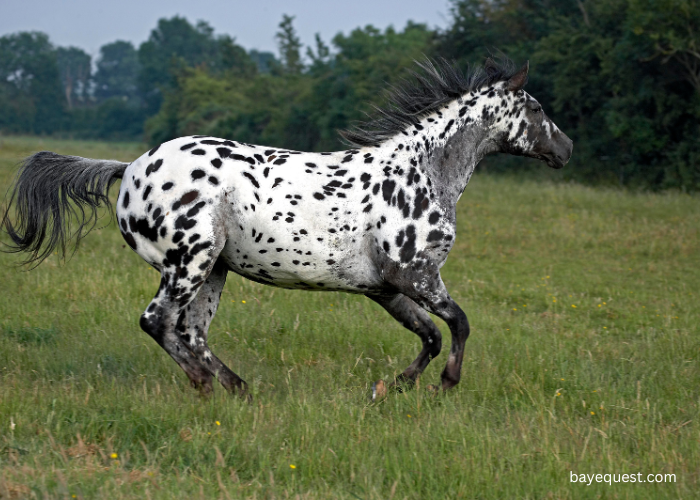
2. Knabstrupper
Hailing from Denmark, the Knabstrupper is a canvas of polka dots. It’s famed for its eye-catching spots and amiable nature.
Originating in the 19th century, this breed showcases a variety of patterns, from leopard spots to marble. Knabstruppers are as versatile as they are vibrant, excelling in dressage and show jumping.
They’re not just performers. They’re partners known for their cool heads and willingness to work. A Knabstrupper is a statement of elegance in motion, a dotted dream on hooves.
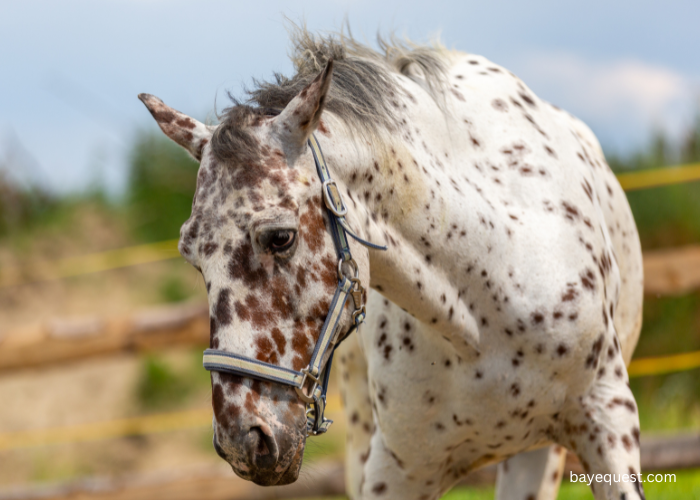
3. Pony of the Americas
This breed is the American dream for young riders. It’s a mid-sized pony with the heart of a horse and a coat dotted like a starry night.
Born from a blend of Shetland Pony, Appaloosa, and Arabian bloodlines, the Pony of the Americas is as friendly as it is sturdy. It is designed for the show ring and family life.
Its coat patterns mirror those of the Appaloosa, but in a more compact frame. This makes it a perfect spotted companion for the next generation of equestrians.
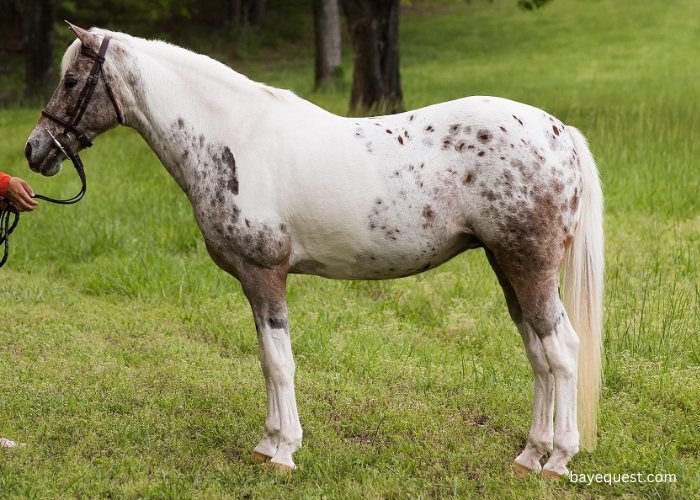
4. British Spotted Pony
A gem of Great Britain, the British Spotted Pony is as enchanting as the ancient forests it once roamed. Small but mighty, these ponies carry the magic of their lineage in every spot and speckle.
With roots tracing back to prehistoric times, they’re a living tapestry of history, embodying endurance and adaptability. Beyond their striking coats, they’re cherished for their gentle dispositions.
When talking ponies, the British Spotted stand out as a piece of living folklore.
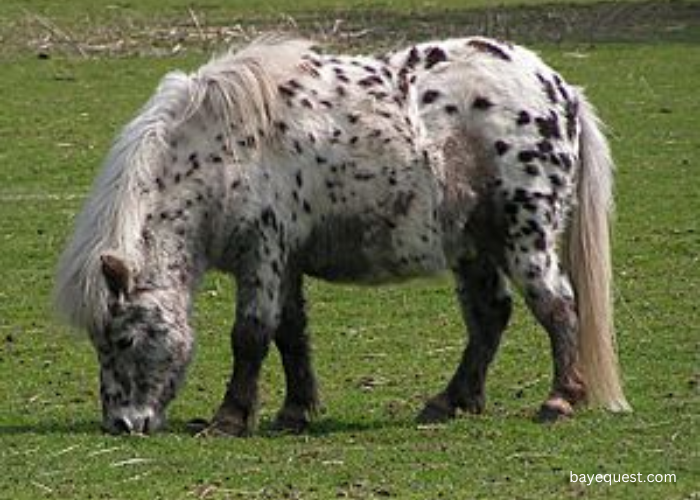
5. Nez Perce Horse
Reviving equestrian heritage, the Nez Perce Horse is a modern twist on ancient mastery. This breed was reborn through the crossbreeding of Appaloosas and Akhal-Tekes.
They are sleek, with a unique blend of spots and a metallic sheen to their coat, mirroring the speed and stamina of their ancestors.
These horses are not just about looks. They’re also bred for their incredible endurance and agile grace.
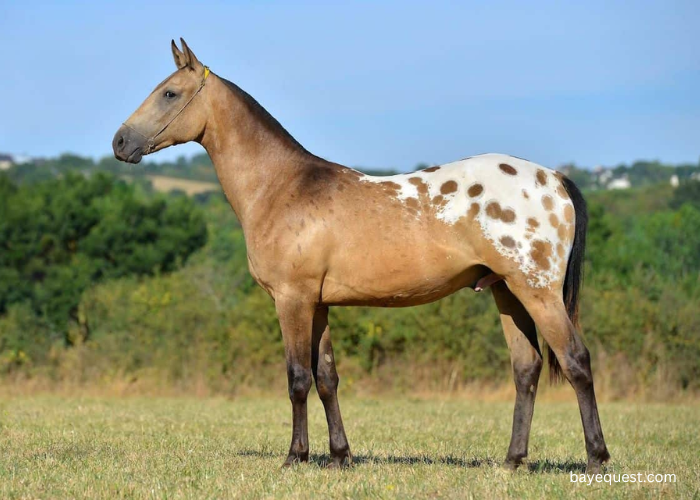
6. Colorado Ranger
Born in the rugged landscapes of the American West, the Colorado Ranger horse is a testament to the beauty of adaptability. With roots tracing back to the Arabian and Barb horses brought by the Spanish, this breed boasts a striking appearance, often adorned with distinctive spotted patterns.
They are versatile, resilient and friendly. Colorado Rangers excel in a variety of disciplines, from rodeo to trail riding.
They carry a piece of the American frontier spirit in every step, a blend of history and heart in their wide, welcoming eyes.
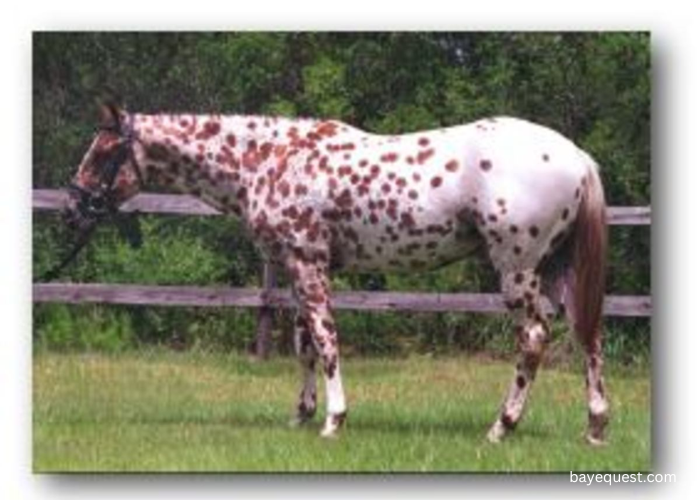
7. American Paint Horse
The American Paint Horse is a canvas in motion. It showcases patterns that look like brush strokes from nature’s own hand.
A blend of Quarter Horse and Thoroughbred, infused with the color genetics of spotted horses, they’re as American as apple pie. These horses have eye-catching coats and are loved for their muscular build, intelligence, and easy-going nature.
Whether in the show ring or on a leisurely trail, an American Paint Horse brings a splash of color to every adventure.
Read also: What is the price of an American Paint Horse?
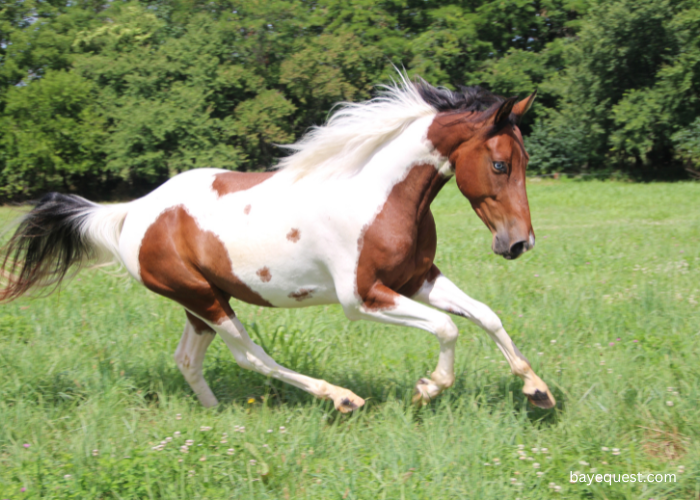
8. Tiger Horse
The Tiger Horse strides out of history with a coat pattern that echoes the wild majesty of its namesake. This breed revives the legacy of ancient, gaited horses known for their spotted coats and smooth rides.
Tiger Horses are bred for their striking appearance and ambling gaits. They are a living nod to the past, combining the beauty of spots with the elegance of movement.
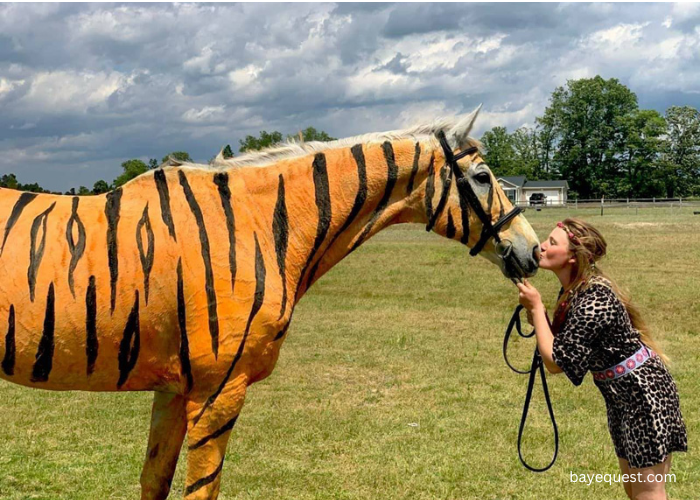
9. Noriker
The Noriker, hailing from the Alpine regions of Austria, is a horse of rugged beauty and strength. Known for their draft capabilities and often adorned with leopard spots or roan patterns, these horses are as majestic as the mountains they come from.
They possess a gentle temperament and a robust build, making them reliable workhorses and companions. The Noriker’s history is intertwined with Roman chariots and medieval knights, a lineage that imbues them with a noble presence.
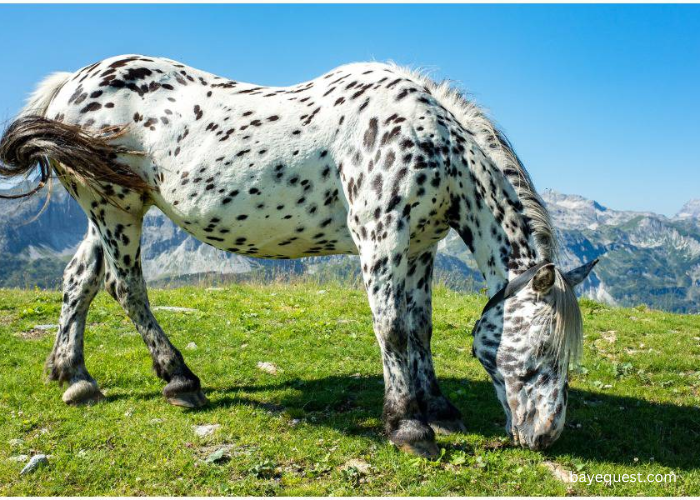
10. American Miniature Horse
The American Miniature Horse may be small in stature, but it’s vast in heart and spirit. These pint-sized equines, standing no taller than 38 inches, are a breed of their own.
They boast a variety of coat colors and patterns, including spots. They capture the essence of their larger counterparts, with all the grace and beauty, in a compact package.
Beyond their adorable appearance, they’re intelligent, friendly, and versatile. They also excel in agility and as therapeutic companions.
The American Miniature Horse proves that great things truly do come in small packages.
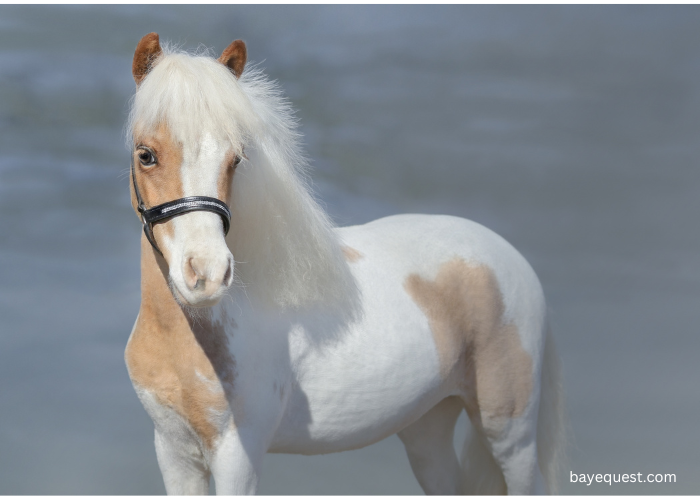
11. Falabella
The Falabella, one of the smallest horse breeds in the world, is a miniature marvel from Argentina. This breed is the result of centuries of selective breeding, creating a horse that encapsulates all the elegance and beauty of a full-sized horse.
With their refined features, including occasionally spotted coats, Falabellas are not just pets but living art pieces. Despite their size, they are strong, hardy, and adaptable, cherished for their gentle nature and intelligence.
The Falabella stands as a testament to the incredible diversity of the equine world, a tiny treasure with a big heart.
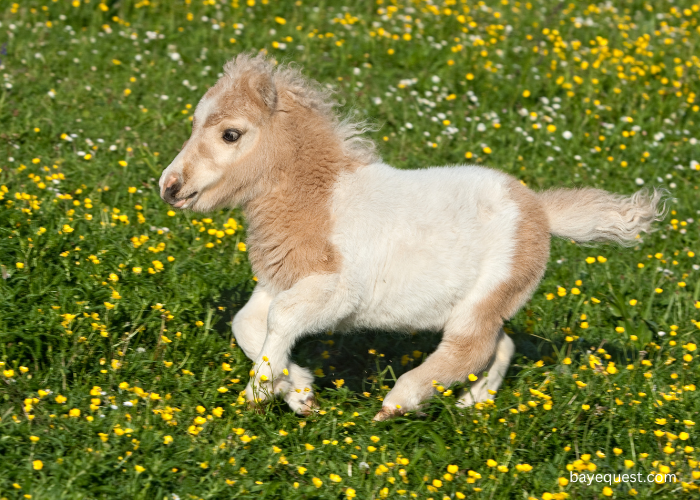
12. Mustang
The Mustang gallops through the heart of American history, a symbol of freedom and untamed spirit. These wild horses are descendants of Spanish, Portuguese, and other European breeds.
With a variety of colors and patterns, Mustangs are celebrated for their resilience, strength, and adaptability. Surviving in harsh environments, they embody the essence of survival and the wild beauty of nature.
Mustangs aren’t just horses. They’re a testament to the enduring spirit of the wild, the pulse of the American West that refuses to be tamed.
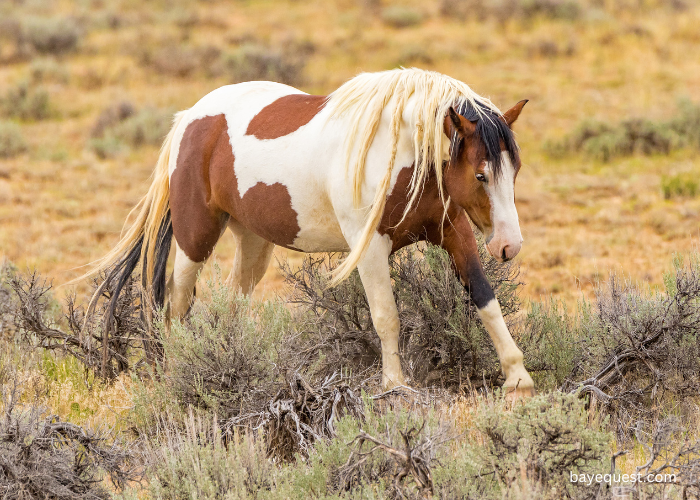
13. Walkaloosa Horse
The Walkaloosa steps out with a unique blend of gait and color, a breed defined by its ambling gait and spotted coat.
This horse is the result of crossing gaited breeds with Appaloosas, aiming to combine the smooth, comfortable ride of a gaited horse with the striking appearance of spots and splashes.
The Walkaloosa is a testament to the pursuit of perfection, offering riders a blend of beauty and functionality. They are also versatile and gentle.
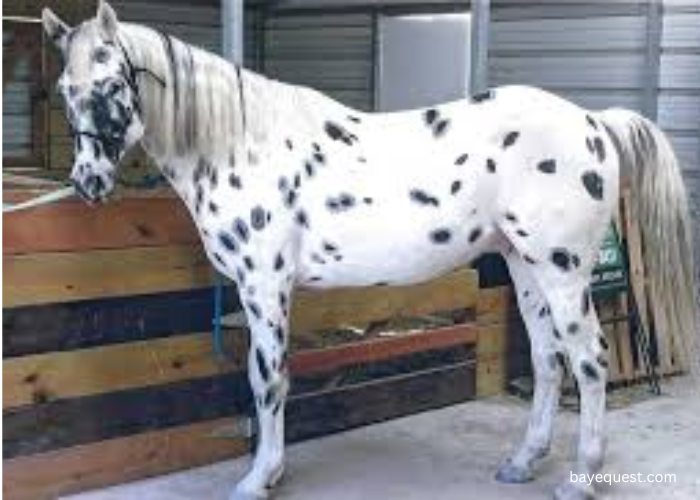
14. Pintaloosa Horse
The Pintaloosa is where paint meets polka dots. This is a horse that carries the legacy of both the Paint and the Appaloosa breeds.
This eye-catching combination results in a horse with a unique coat pattern, featuring both patches and spots. Pintaloosas inherit the best traits of their ancestors, including a strong and muscular build.
This breed is a colorful celebration of diversity, proving that when it comes to horses, the most beautiful traits can come in the most vibrant packages.
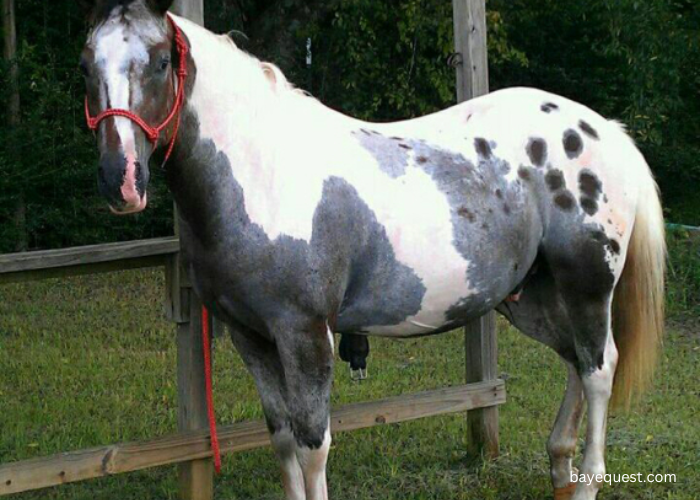
What You Should Look for When Purchasing a Spotted Horse Breed
When you’re setting your sights on buying a spotted horse, there’s more to consider than just the dazzle of their coat. Here’s a friendly guide to keep you on track.
First off, think about temperament. You want a horse that’s as good-natured as it is good-looking. A calm, easy-going personality is a big plus, especially if you’re looking for a family companion or a reliable ride.
Next, peek under the hood – or in this case, under the coat. Health is key. Clear eyes, sound hooves, and a hearty appetite are all signs you’re looking at a horse in tip-top shape. Don’t shy away from asking for health records; a trustworthy seller will have them ready.
Let’s talk training and experience. What’s this spotted beauty been up to? Whether you’re eyeing the show ring or the trails, you’ll want a horse that matches your ambition. A well-trained horse makes for a smoother ride and a happier partnership.
Don’t forget about the breed specifics. Each spotted horse breed comes with its own set of characteristics and potential health concerns. Do your homework. Knowing what to expect can save you from surprises down the road.
Lastly, consider compatibility. This isn’t just about picking a horse; it’s about finding your new best friend. Spend time together. A ride, a grooming session, a simple hangout can tell you a lot about how well you’ll click.
Buying a spotted horse is an adventure. Keep these pointers in mind, and you’re more likely to end up with a horse that’s not just a pretty face, but a true companion for the journey ahead.
Read also: Pretty Horse Breeds in the World.
Characteristics and Temperaments of Spotted Breeds
Spotted horse breeds come with a splash of color and a bundle of personality. Here’s a quick look at what makes them special.
Friendly. Many spotted breeds are known for their gentle, easy-going nature. They make great companions and family horses.
Smart. These horses are quick learners. They’re often eager to please, making training a rewarding experience.
Versatile. Whether it’s riding, jumping, or driving, spotted horses can do it all. Their adaptability is a big plus.
Strong. They’re not just pretty faces. Many spotted breeds have a sturdy build, ready for work or play.
Loyal. A spotted horse can be your steadfast friend. They often form strong bonds with their owners.
Energetic. Expect some pep in their step. These horses can have a lively spirit, ready for adventure.
Sensitive. They’re not just muscle and might. Spotted horses can be sensitive and responsive, tuned in to their rider’s cues.
Health Considerations for Breeds of Spotted Horses
Spotted horse breeds, while hardy and resilient, have specific health considerations that you should be aware of. Here’s a straightforward rundown:
Skin sensitivity. The unique pigmentation of spotted horses can make their skin more susceptible to sunburn. This is more true in lightly colored or white areas. Regular sunscreen application and shaded shelters are helpful. (Find out other horse skin conditions and diseases that your equine friends may be susceptible to.)
Congenital Stationary Night Blindness (CSNB). This condition is known to affect certain breeds like the Appaloosa. It impairs a horse’s ability to see in low light or darkness, but they can adapt well to their environment with consistent care.
Coat Color Dilution Alopecia. Some speckled horses may experience hair thinning or loss in areas of diluted pigment. Keeping an eye on skin and coat health, along with regular vet checks, can manage this condition.
Equine Recurrent Uveitis (ERU). Also known as moon blindness, this eye condition can affect horses of any breed but is seen more frequently in Appaloosas. Regular veterinary eye exams are crucial for early detection and management.
Polysaccharide Storage Myopathy (PSSM). A muscle disorder that affects some horse breeds, leading to muscle stiffness, pain, and reluctance to move. A diet low in starches and sugars, along with regular exercise, can help manage symptoms.
Hoof care. Like all horses, spotted breeds require regular hoof care to prevent issues like laminitis or hoof cracks. Hoof boots for trail riding and routine farrier visits are key to maintaining healthy hooves.
Genetic testing. Genetic testing can be a valuable tool for breeds with known hereditary conditions. This helps to make informed breeding decisions and prepare for potential health needs.
Care and Maintainance of Spotted Horse Breeds
Taking care of a spotted horse is much like caring for any horse, but with a few special considerations to keep them looking and feeling their best.
First things first, a balanced diet is crucial. This means good quality hay or grass, grains as needed, and plenty of fresh water. Just like us, each horse has its own dietary needs, so keep an eye on their condition and adjust food accordingly.
Next up, grooming. Spotted coats can be quite the showstopper, so regular grooming is a must.
It not only keeps their coat shiny and healthy but also gives you a chance to check for any skin issues. Pay special attention to areas under the tack to prevent irritation, and apply sunscreen and insect repellant.
Exercise and regular veterinary care are non-negotiables. Spotted horses, like all horses, need plenty of exercise to keep fit and happy. Regular vet check-ups, vaccinations, and deworming will help catch any health issues early and keep your horse in top shape.
Let’s not forget about hoof care. Regular trims and checks are essential to prevent problems like cracks or laminitis. A healthy hoof supports a healthy horse, so make sure your farrier visits are on schedule.
Lastly, stay informed and vigilant about potential health conditions. With love, attention, and proper maintenance, your spotted horse will thrive.
The Role of Spotted Horse in Folklore and Mythology
Spotted horses have trotted through many tales and legends across the world, casting a mystical spell in folklore and mythology.
In Native American stories, these horses often symbolize magic and freedom. They are believed to carry heroes and shamans on their adventures.
European tales tell of magical spotted horses with powers, like the ability to speak or heal. They guide their riders through dark forests and enchanted lands.
In some cultures, a spotted horse is seen as a good luck charm, bringing fortune and protection to those they accompany.
These horses also appear in myths as creatures with special connections to the gods. Sometimes, they serve as divine messengers or as mounts for deities.
Their striking coats are not just about beauty; they’re seen as a cloak of power, each spot a story, a secret, or a spell.
FAQs
Is the Walkaloosa Horse a type of Appaloosa?
Not really. The Walkaloosa Horse is not a type of Appaloosa. However, it shares the Appaloosa’s characteristic spotted coat pattern. The Walkaloosa is bred for its unique ambling gait, combining traits from gaited horses and those with Appaloosa lineage.
Are Icelandic Horses spotted horses?
Icelandic Horses are not categorized as spotted horses. While they come in many colors and patterns, the classic spotted patterns seen in breeds like the Appaloosa or the Knabstrupper are rare among Icelandic Horses. They are known for their unique gaits and sturdy build.
Spotted Horse Breeds: Conclusion
As we wrap up our journey through the world of spotted horse breeds, it’s clear these horses are more than just their stunning coats. They carry history, magic, and a versatility that’s unmatched.
From the ancient walls of caves to the hearts of horse lovers today, spotted horses have galloped through time, captivating us all. Whether it’s the loyalty of an Appaloosa, the grace of a Knabstrupper, or the energy of a Pony of the Americas, there’s a spotted horse for every story.
Their roles in folklore, their unique characteristics, and the efforts to preserve them remind us of the special place they hold in our world. Here’s to the spotted horses—may their stories continue to inspire and enchant us.




